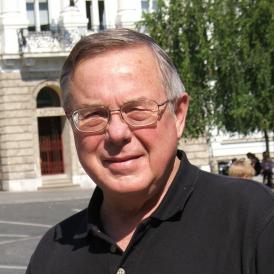
Email:
Office:
Phone:
Courses:
Affiliations:
Biography:
Prof. Dewey holds a Bachelor of Science degree in Mechanical Engineering from Yale University, Master of Science from Stanford and a PhD from Caltech. He joined the faculty of MIT as an Associate Professor of Mechanical Engineering in 1968 and was a Member of the faculty Health Sciences & Technology, Harvard and MIT 1983-2003. Prof. Dewey has held Visiting positions at many international academic institutions, including Institut für Plasmaphysik, Garching, Germany, Imperial College, London, and Nanyang Technological University, Singapore.
Research:
Probing the effects of mechanical forces on living cells
The primary medical problem that my research group investigates is atherosclerosis. The lumen of the arterial wall is lined with endothelial cells that respond to the mechanical forces of blood flowing through the arteries. The endothelium protects the artery wall from inflammatory reactions that result in atherosclerosis. Our lab was the first to demonstrate the time-course with which endothelial cells reorganize and reorient in the direction of fluid flow, and we continue to use microscopy to probe the fundamental mechanisms of this response.
My research group uses microscopy to probe the effects of mechanical forces on living cells. Our targets of interest, endothelial cells, protect the artery wall from the inflammatory reactions that result in atherosclerosis. The cells have a mechanical structure that depends on a network of polymerized actin molecules, and they are covered with a layer of glycosaminoglycans of around 400 nm in thickness, called the Endothelial Glycocalyx layer (EGL). The EGL is a major determinant of their state and their interactions with external flow. Fluorescent dyes are used as markers to tag individual molecules of actin, NO, VE Cadherin, Heparin Sulfate and other molecules that are important to cellular function and biological response. Our current focus is on the EGL, and we are using super-resolution optical imaging to track the motion of EGL structures to better than 15 nm in three dimensions. These measurements provide information on the mechanical properties of the EGL, and will lead to theoretical estimates of how the EGL is distorted by blood flow and hopefully reveal the fundamental mechanisms of how mechanical force is transduced into biochemical signals.
Quantitative computational models of the molecular biology of cardiac cells.
We are also undertaking a major development program to create a new computational modeling environment where experimental data can be correlated using quantitative molecular modeling across a diverse number of individual experiments. This work has produced a new program called Cytosolve that is capable of solving a very large number of molecular pathway models simultaneously. The architecture allows the complexity to grow linearly with the number of models, in contrast to the literally unscaleable methods that have been proposed in the past. Early example applications have been extremely encouraging, and this effort is poised for expansion. We are currently applying our computational modeling to the problem of enhanced cardiac muscle death following reperfusion of an ischemic heart. Ironically, a significant fraction of the cardiac damage done following occlusion of a coronary artery happens at the time the clot is removed and the blood flows back into the ischemic region. The details of this response a critical to the understanding of this portion of cardiac damage, and a solution would offer very significant benefits to victims of heart attacks.


